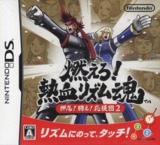Ouendan 2 is an excellent continuation of one of the best rhythm game formulas on any platform.
The basic gameplay in Ouendan 2 is unchanged from that of the previous games. The game features a total of nineteen stages, each featuring a person or people in dire straights. When they can't take the pressure any more, they shout "OUENDAN!", and the cheer squad leaps into action to cheer them on and help them succeed. When the music starts, the player must perform various actions in time with the music by interacting with the touch screen. These include tapping numbered markers in sequence, sliding the stylus along tracks, and spinning wheels by twirling the stylus around the center of the touch screen. The more accurate that the player is, the more energy is retained in a life gauge that is constantly depleting. At periodic breaks during the song, the top screen will display a scene showing the progress of the person the player is cheering on. If the player is doing well and the energy gauge is in the yellow, then the scene will indicate a success, but if the gauge is in the red, the stage's protagonist will suffer a setback.
What separates Ouendan 2 from the original game in terms of its gameplay is in the way that the marker patterns are constructed. In the original game, the markers were laid out in a fairly linear fashion. Ouendan 2, on the other hand, uses more complex marker patterns more in line with EBA that should keep Ouendan and EBA veterans on their toes, while multiple difficulty levels ensure that newcomers won't become lost as they aid those in need.
And speaking of those in need, the scenarios that the game presents are just as outlandish as those present in the original game, if not more so. A sampling of clients that the cheer squad will face include a shoe salesman forced to sell his wares to aliens in outerspace, a trio of engineers that build a giant robot to fight the monstrous feline Nyaragon, and bonus scenarios that include a wireless signal (in the form of a classical samurai) that needs to deliver a text message. Topping things off is the fact that the cheer squad now has a rival squad to contend with, with the nineteen stages roughly divided in half between them.
In terms of the musical selection, fans of J-pop should recognize a number of the songs in the soundtrack, though most of them are cover versions. LIke Ouendan and EBA, Ouendan 2's song list is a mix of genres ranging from recent hits on back to the 1970s. Most of the songs on the list are of great quality, although as is often the case with rhythm games, tastes for the soundtrack will vary.
In the more technical aspects of the game, Ouendan 2 features all of the improvements made in EBA, including the ability to save replay data, crisper 2D and 3D animation, and more robust multiplayer features. For experts that have mastered the game, Ouendan 2 also features an unlockable option that hides the timer halos that clue the player in on when to hit each marker, greatly increasing the challenge.
Ouendan 2 is the perfect example of how a rhythm game sequel should be made. The game introduces more challenging beat patterns while making the game more accessible to newcomers, offers a high quality selection of popular Japanese music, and enhances the look and feel without needlessly altering the already rock solid gameplay. Although Ouendan 2 probably won't see the light of day at western retail markets in a localized form, it's a game well worth importing and requires no knowledge of the Japanese language in order to enjoy.

